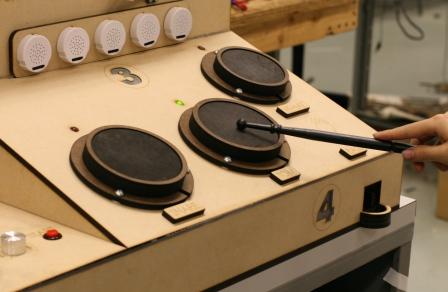
Our Game
Overall Game Description: Our Penny Arcade Game is old school penny arcade meets Guitar Hero plus some rock and roll style drum playing. The idea of the game is that the user follows the gameís lead and hits a drum when signaled to do so (with LEDs) in order to play a certain rhythm. Either a drum sound or a bad sound is played when a player hits a drum, depending on if they are hitting it at the correct time. At the end of the game, the score (percentage of correct notes played) is pointed to by the arrow of a Star-o-Meter. A chocolate ball is dispensed for high scores. During the game, numbers light up next to the instruction step (on the gameís backboard) and the location referred to by the instruction to indicate what is the current stage of the game.
Our Penny Arcade Game is old school penny arcade meets Guitar Hero plus some rock and roll style drum playing. The idea of the game is that the user follows the gameís lead and hits a drum when signaled to do so (with LEDs) in order to play a certain rhythm. Either a drum sound or a bad sound is played when a player hits a drum, depending on if they are hitting it at the correct time. At the end of the game, the score (percentage of correct notes played) is pointed to by the arrow of a Star-o-Meter. A chocolate ball is dispensed for high scores. During the game, numbers light up next to the instruction step (on the gameís backboard) and the location referred to by the instruction to indicate what is the current stage of the game.
Video: Drum Hero ExplainedClick here for actual video (non-Youtube version) Core Functionality Descriptions:Instructional Numbers (LEDs)Instructions for the game are displayed on the backboard of Drum Hero. Each instruction has next to it an acrylic number with LEDs behind it as well as a corresponding number with LEDs located next to the part of the game the instruction refers to. The user is led through the game by the LEDs, which turn on to indicate what step of the game the user is at. Penny insert sensing (slot sensor) The slot sensor sends a high when a penny is dropped into an indicated slot on Drum Hero. The slot is postioned so the penny will pass through the sensorís slot, signaling the start of game. Level of difficulty selection and Start game button (potentiometer & push button) [2 INTERACTIONS, 1 ANALOG] The user turns a knob (on a potentiometer) to select their desired level of difficulty (easy, medium, or hard). The difficulty level sets the speed of the drum playing part of the game. The user then pushes a ďStart GameĒ button to signal that they have selected their level of difficulty and are ready to start playing.  Drum LED indicators (LEDs)
Drum LED indicators (LEDs)[1 REACTION, VISUAL SENSE/ VARIABLE LEVELS OF REACTION] Different colored LEDs (located next to their associated drum or, in the case of the foot pedal, near the graphical representation of a foot) identify which drum the user should hit at a certain time. The LEDs light when preset arrays indicate which drums should be hit at what time times. The speed of the song (and thus of the LED lighting) depends on the level of difficulty selection, with harder games being faster. Drum hit sensing (piezoelectric sensors) [1 INTERACTION] The user should hit a drum when its LED lights up. Foot pedal sensing (slot sensor) [1 INTERACTION, NON-CONTACT] When the user presses down on the foot pedal, the beam of a slot sensor within it is broken, indicating the foot pedal has been pressed. Drum sounds (sound generators) [1 REACTION, AUDIO SENSE/VARIABLE LEVELS OF REACTION] A sound will be played when a drum hit or pedal depression is sensed. If that drum/pedal was not the one indicated by the LEDs a bad sound will play. If it is the correct one, the sound will be the one appropriate to the drum/pedal that has been hit/depressed. Score indicator (servo motor) [1 REACTION, ELECTROMECHANICAL] At the end of the game, an arrow (attached to a servo motor) turns to indicate the userís score (a percentage based on the userís number of correct drum hits to total number of notes). It holds its position for five seconds. SWAG dispenser (DC motor) After the userís score has been indicated, and they hit 66% or more of the correct notes, a ball of chocolate is dispensed to the user. The dispenser consists of two layers connected with a turntable (a ME 210 ball holder design). One layer has holes around its circumference to hold each candy in place and the layer beneath it has one hole. The DC motor turns the top layer, which results in the balls of chocolate to fall through the hole. The ball then travels down a ramp out to a small tray for the user to pick it up. |